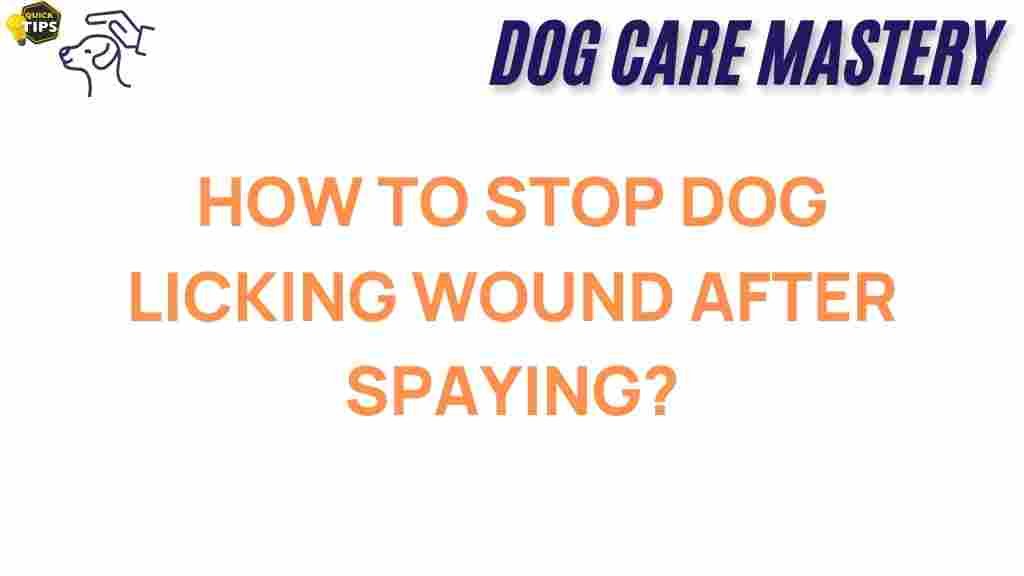Effective Strategies to Prevent Your Dog from Licking a Spay Wound
As a responsible pet owner, ensuring your dog’s health and well-being is a top priority. After a spay surgery, it is crucial to monitor your dog’s recovery closely, particularly to prevent your dog from licking the spay wound. Licking can lead to infections, delayed healing, and other complications. In this article, we will explore effective strategies to keep your dog from licking their spay wound and promote a smooth recovery.
Understanding Why Dogs Lick
Before diving into prevention strategies, it’s essential to understand why dogs lick their wounds. Licking is a natural behavior for dogs, serving several purposes:
- Self-soothing: Dogs often lick wounds to alleviate pain or discomfort.
- Exploration: Dogs use their mouths to explore their environment, including their bodies.
- Cleaning: Licking is a way for dogs to clean their wounds, but this instinct can be detrimental post-surgery.
Understanding these behaviors can help you implement effective strategies to prevent your dog from licking their spay wound.
Step-by-Step Process to Prevent Licking
Here are several strategies pet owners can adopt to prevent their dogs from licking their spay wounds:
1. Use an Elizabethan Collar
The most common method to prevent your dog from licking is the use of an Elizabethan collar (often referred to as an “E-collar”). This cone-shaped device prevents dogs from reaching their wounds.
- How to use: Ensure the collar fits snugly around your dog’s neck but is not too tight. Adjust as necessary for comfort.
- Tip: Monitor your dog while they adjust to wearing the collar, especially during the first few days post-surgery.
2. Consider Alternative Collars
If your dog is uncomfortable with a traditional E-collar, consider alternative options:
- Inflatable collars: These provide a softer alternative while still preventing licking.
- Soft fabric collars: These collars can be more comfortable and less restrictive than traditional E-collars.
3. Use a Recovery Suit
A recovery suit is a garment designed to cover your dog’s body and protect the spay wound. These suits can be more comfortable for your dog and can help prevent licking without the bulk of a collar.
- How to choose: Ensure the suit is the right size and fits snugly to prevent your dog from reaching the wound.
- Ease of use: Look for suits that are easy to put on and take off, especially during bathroom breaks.
4. Keep Your Dog Occupied
Distracting your dog can help prevent them from focusing on their discomfort and licking their wound:
- Toys: Provide stimulating toys that can keep your dog engaged.
- Interactive puzzles: These can challenge your dog mentally and keep their minds off the healing process.
- Quality time: Spend time with your dog to keep them distracted and provide comfort.
5. Monitor Your Dog’s Activity
Limiting your dog’s physical activity can help reduce their instinct to lick:
- Short walks: Keep walks brief and avoid playtime that may cause your dog to lick their wound.
- Safe space: Create a quiet, comfortable area for your dog to rest and recover without distractions.
6. Use Bitter Spray
Applying a bitter-tasting spray around the wound can deter your dog from licking:
- Application: Follow the instructions carefully to ensure safety and effectiveness.
- Consult your vet: Always check with your veterinarian before using any sprays to ensure they are safe for your dog.
Troubleshooting Tips
Even with preventive measures in place, some dogs may still attempt to lick their wounds. Here are some troubleshooting tips:
1. Assess Comfort Levels
If your dog seems overly stressed or uncomfortable, it may be worth reassessing the chosen method. A snug E-collar might be causing distress; consider switching to a recovery suit or a different type of collar.
2. Monitor the Wound Closely
Keep a close eye on the spay wound for any signs of infection or irritation. If you notice redness, swelling, or discharge, contact your veterinarian immediately.
3. Provide Extra Comfort
Post-surgery can be a challenging time for dogs. Providing extra comfort through soft bedding, blankets, and soothing music can make a significant difference.
4. Consult Your Veterinarian
If your dog continues to lick despite all preventive measures, it may be time to consult your veterinarian. They can provide additional advice or medications that may help calm your dog and promote healing.
Conclusion
Preventing your dog from licking a spay wound is essential for a smooth recovery. By understanding the reasons behind this behavior and implementing the strategies outlined in this article, you can help ensure your dog heals properly. Whether you choose an Elizabethan collar, a recovery suit, or distraction techniques, the key is to stay vigilant and proactive during your dog’s healing process.
If you’re looking for more pet care tips, be sure to check out our comprehensive guide on post-surgery care for dogs. Remember, a little extra care goes a long way in ensuring your furry friend recovers swiftly and comfortably!
For more information on pet health and care, visit PetMD.
This article is in the category Health and created by dogcaremastery Team
